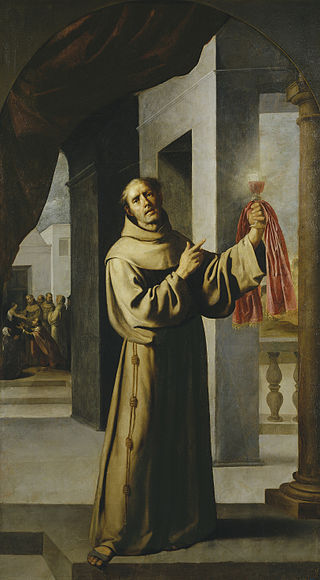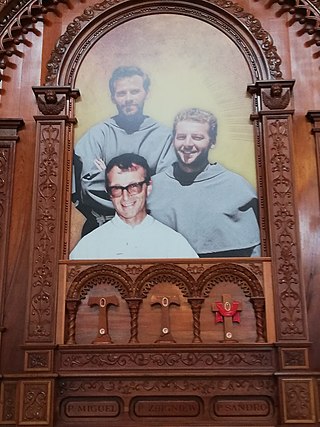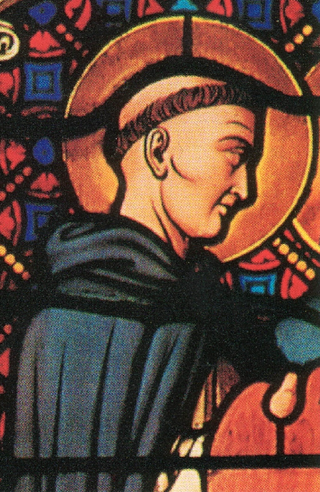
The Franciscans are a group of related mendicant religious orders of the Catholic Church. Founded in 1209 by the Italian saint Francis of Assisi, these orders include three independent orders for men, orders for nuns such as the Order of Saint Clare, and the Third Order of Saint Francis open to male and female members. They adhere to the teachings and spiritual disciplines of the founder and of his main associates and followers, such as Clare of Assisi, Anthony of Padua, and Elizabeth of Hungary. Several smaller Protestant Franciscan orders or other groups have been established since late 1800s as well, particularly in the Anglican and Lutheran traditions.

The Order of Friars Minor Capuchin is a religious order of Franciscan friars within the Catholic Church, one of three "First Orders" that reformed from the Franciscan Friars Minor Observant, the other being the Conventuals (OFMConv). Franciscans reformed as Capuchins in 1525 with the purpose of regaining the original Habit (tunic) of St. Francis of Assisi and also for returning to a stricter observance of the rule established by Francis of Assisi in 1209.

John of Capistrano, OFM was a Franciscan friar and Catholic priest from the Italian town of Capestrano, Abruzzo. Famous as a preacher, theologian, and inquisitor, he earned himself the nickname "the Soldier Saint" when in 1456 at age 70 he led a Crusade against the invading Ottoman Empire at the siege of Belgrade with the Hungarian military commander John Hunyadi.
Giovanni Battista Righi was an Italian Roman Catholic priest and a professed member from the Order of Friars Minor. He was known for ascetic life and for his preaching and healing abilities.

Albert Berdini of Sarteano was a Franciscan friar and preacher. He was an associate of Bernardino of Siena, and a diplomatic envoy of Pope Eugene IV to the Coptic and Ethiopian churches.

Jacob de Marchia, commonly known in English as Saint James of the Marches, was an Italian Friar Minor, preacher and writer. He was a Papal legate and Inquisitor.

Angelina of Marsciano, T.O.R. was an Italian religious sister and foundress, and is a beata of the Roman Catholic Church. She founded a congregation of religious sisters of the Franciscan Third Order Regular, known today as the Franciscan Sisters of Blessed Angelina. She is generally credited with the founding of the Third Order Regular for women, as her religious congregation marked the establishment of the first Franciscan community of women living under the rule of the Third Order Regular authorized by Pope Nicholas V.

Gaetano Errico, MSSCC was an Italian Catholic priest from Naples and the founder of the Missionaries of the Sacred Hearts of Jesus and Mary.

Pacificus da Ceredano - born Pacificus Ramati - was an Italian Roman Catholic priest and a professed member from the Order of Friars Minor. Pope Benedict XIV approved his "cultus" and beatified him on 7 July 1745.

Theophilus of Corte - born Biagio Arrighi - was an Italian Roman Catholic priest and a professed member from the Order of Friars Minor. Arrighi became known for his preaching and evangelization efforts and acted as a reformer in establishing houses for the Franciscans in northern Italian cities and throughout the Corsica island where he was born. He was known for his cheerful demeanor and his willingness to assist others while also known for his tireless dedication to silence and solitude which he exhorted his fellow friars to exercise in order to better commune with God.

The Three Martyrs of Chimbote were a group of two Polish Franciscan priests and one Italian missionary priest murdered in Peru in 1991 by the Shining Path communist guerillas. Michał Tomaszek and Zbigniew Adam Strzałkowski, and Alessandro Dordi were murdered on 9 August and 25 August 1991 respectively.

Leopoldo da Gaiche, born Giovanni Croci, was an Italian Roman Catholic priest and a professed member of the Order of Friars Minor who became well known for wearing a crown of thorns. He was a preacher who went from diocese to diocese and served in a position of power in the Franciscan order in the Umbrian region in which he pushed for strong adherence to the Rule of Saint Francis of Assisi. He has been called the "Apostle of Umbria".

Blessed Ladislas of Gielniów was a Polish Roman Catholic priest and a professed member of the Order of Friars Minor. He was an observant of the Rule of Saint Francis of Assisi and served his order in various capacities that included both a doorkeeper and as its provincial. He also travelled across Poland to evangelize to the faithful and was a noted preacher.

The Order of Friars Minor is a mendicant Catholic religious order, founded in 1209 by Francis of Assisi. The order adheres to the teachings and spiritual disciplines of the founder and of his main associates and followers, such as Clare of Assisi, Anthony of Padua, and Elizabeth of Hungary, among many others. The Order of Friars Minor is the largest of the contemporary First Orders within the Franciscan movement.

Luca Antonio Falcone – in religious life Angelo – was an Italian Roman Catholic priest and a professed member of the Franciscan Order of Friars Minor Capuchin in Cosenza. Falcone had a rough call to religious life after several entries and exits into the order and he later served as a noted preacher across southern Italian cities such as Catanzaro and Salerno after his first few sermons attracted little following. He became titled as both the "Angel of Peace" and the "Apostle of the South".

Blessed Marco da Montegallo was an Italian Roman Catholic priest from the Order of Friars Minor. He was born to a nobleman and served as a doctor in Ascoli Piceno before he was pressured into marriage in 1451 - the couple annulled their marriage after both entered the religious life. Father Marco is best known for establishing pawnshops for the poor across various Italian cities and for being a preacher of love.
Giovanni da Penna was an Italian Roman Catholic priest and a professed member of the Order of Friars Minor. He became a Franciscan in 1213 after hearing Fra Filippo - one of the disciples of Francis of Assisi - preach. He spent over two decades in France where he oversaw the establishment of Franciscan houses before returning to the Italian peninsula where he served his life in quiet cloistered retirement.
Antonio da Stroncone was an Italian friar of the Order of Friars Minor. He became a member of that order in his youth after cultivating a strong devotion to Francis of Assisi during his childhood with his parents who were members of the Third Order of Saint Francis.

Gregorio Celli was an Italian priest of the Roman Catholic Church and a professed member of the Order of Saint Augustine. Celli lived with the latter order in Rimini until he decided to spend the remainder of his life in deep contemplation and so moved to the region's hills where he dwelled in a cave near the Franciscans stationed there. It is claimed he was expelled from his order and became a Franciscan though there is no evidence to support this claim.

André Abellon, O.P. was a French Roman Catholic priest and a professed member from the Order of Preachers. He became a Dominican after hearing the preaching of Vincent Ferrer and studied art before joining their ranks. Abellon gained fame as a noted preacher and confessor but became a prominent figure after tending to victims of the plague in Aix-en-Provence in 1445. He was also a noted artist and painter with some of his works still surviving at present.















